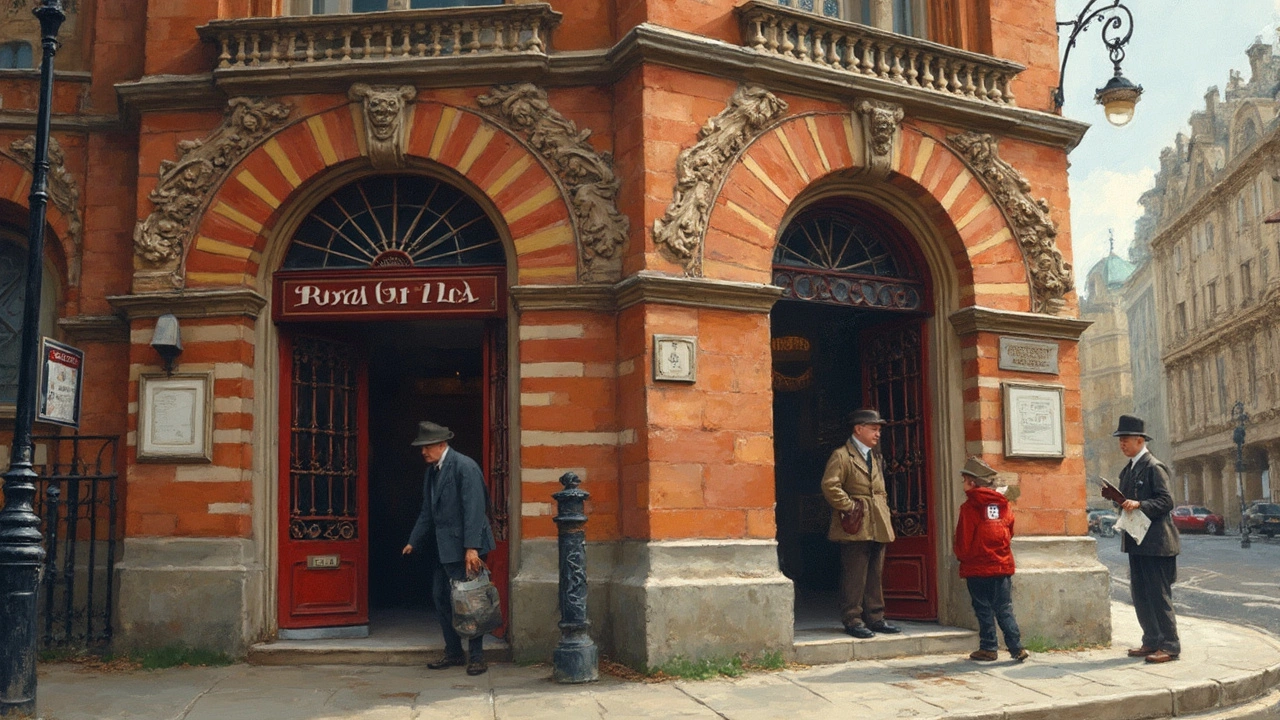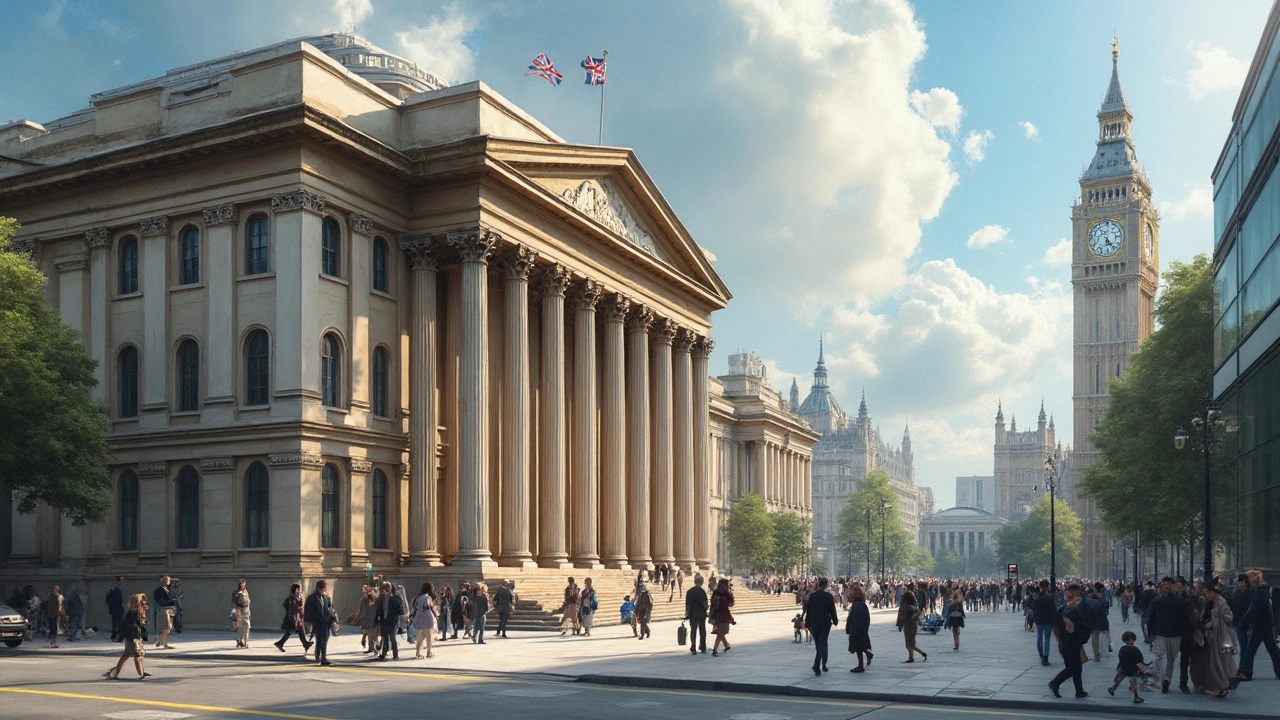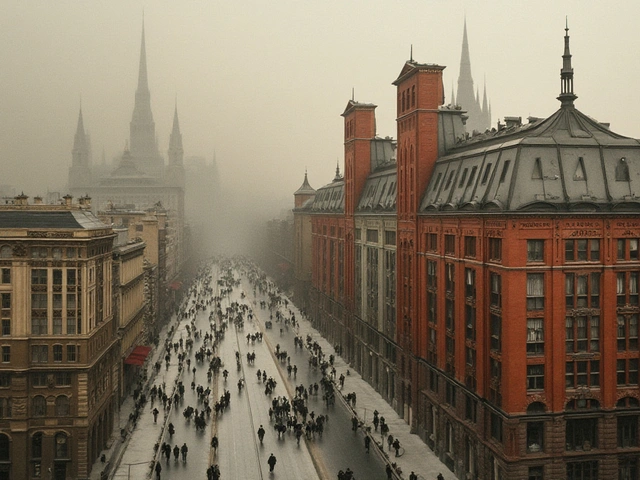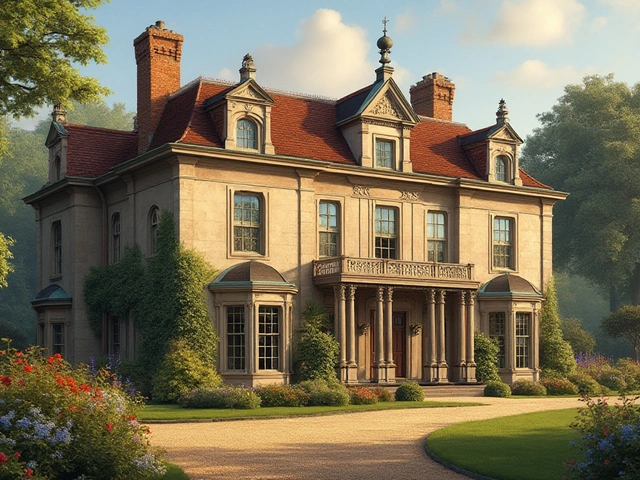Think federal buildings are just dull boxes with government seals slapped on? Think again. Whether it’s a post office in a small town or the stately Supreme Court in Washington, these spots all follow a playbook, but each one does it with its own spin. You’re surrounded by federal architecture almost everywhere in America—you just have to know what you’re looking for.
Every window, column, and hallway in these buildings tells you something about the country and the era in which it was built. Spot a domed roof or those tall, chunky pillars? You’re seeing a throwback to ancient Rome and Greece, which the first American leaders picked on purpose to send a message about democracy and order. Don’t be surprised if you see the same classical touches on an old post office as you do on the Capitol dome.
Even if you’re not into history, visiting these buildings can seriously change how you see your own city. Some are open for tours and packed with surprising details—murals painted during the New Deal, secret courtyards, or even quirky old elevator dials. You’ll come away with a whole new appreciation for the places you walk past every day.
- What Makes Federal Architecture Stand Out?
- The Classic Styles and Their Features
- Regional Variations and Surprising Finds
- Behind the Facade: Function and Symbolism
- Tips for Spotting Federal Architecture in Your City
- How Modern Trends Are Shaping Federal Buildings
What Makes Federal Architecture Stand Out?
Federal buildings don’t just blend into the background—they’re made to look the part of officialdom. One look at most old courthouses or government offices, and you’ll see they don’t try to hide their purpose. That’s on purpose. Federal architecture has this knack for sending a message: here’s a place that’s safe, stable, and solid—qualities people expect from the government.
Walk by a federal building, and you’ll spot some common features: big steps leading to the front door, stone columns flanking the entrance, heavy doors, and thick walls. These design choices go all the way back to the late 1700s when the new country wanted to prove it was serious and built to last. They picked elements from ancient Greece and Rome because those places stood the test of time. And it wasn’t just about looks—it was about making you feel a certain way the second you walk inside.
- Symmetry: Nearly every federal building, no matter the era, loves a good balanced look. Both sides of the main entry usually match up perfectly.
- Classical details: Massive columns, domes, and triangular pediments are not accidents. They’re direct call-backs to democracy and justice.
- Grand scale: Some of these buildings are built to impress. Big lobbies, cavernous halls, and high ceilings signal power and openness.
- Public artwork: Murals, sculptures, mosaics—these aren’t just for show. Back in the 1930s, the government hired artists to decorate post offices and courthouses to give everyone something uplifting in tough times.
Not every federal building is a marble palace, though. Some are modest, using brick or concrete to match the local vibe. But they still keep a few signature features, like a flagpole out front or an eagle crest above the door. This creates a look that’s easy to spot once you know what to look for.
The style has evolved, too. If you look at a modern federal courthouse—think glass, steel, and open floorplans—you’ll notice the sense of order and purpose is still there. The names may change, but the game is the same: remind you you’re stepping into a government building that matters.
| Era | Common Features | Example |
|---|---|---|
| Early Republic (1790-1850) | Stone, columns, domes | U.S. Capitol |
| New Deal Era (1930s) | Murals, streamlined shapes | San Francisco Mint |
| Modern (post-1970) | Glass, steel, open spaces | Thomas F. Eagleton Courthouse |
So next time you see a post office or federal courthouse, notice how it stands out from everything else around. That’s pretty much by design.
The Classic Styles and Their Features
Think of federal architecture and classic styles like Neoclassical, Greek Revival, and Beaux-Arts come straight to mind. These aren’t just random picks—each one was chosen to send a message and look the part. The government wanted these places to feel official, sturdy, and open to the people, so they borrowed from traditions that already screamed importance.
Neoclassical is probably the style most folks picture. You see it in the U.S. Capitol and the White House—big columns, domed roofs, wide stairs leading up to giant entryways. These designs mimic ancient Greek and Roman temples to show off stability and democracy. Even smaller federal buildings in regular towns leaned on the same vibe, just scaled down.
Greek Revival took all that column action and ran with it. In the early 1800s, you’d find post offices and courthouses with triangle pediments—those pointy bits above the door—plus more columns than you thought possible. This style was pretty much everywhere between 1820 and 1860, especially in boomtowns that wanted to put themselves on the map.
Then there’s Beaux-Arts, which brought a little drama starting in the late 1800s. If you see a federal building with fancy stone carvings, massive staircases, and big domed lobbies decked out with mosaics and gold leaf, that’s Beaux-Arts showing off. The old New York Public Library and Union Station in D.C. nailed this look, mixing serious engineering with loads of decoration.
- Neoclassical: Domed roofs, big columns, symmetrical shapes—think of the Supreme Court or Treasury Building.
- Greek Revival: Right-angled pediments, fluted columns, usually painted white for that "temple" effect.
- Beaux-Arts: Over-the-top details, stone carvings, wide staircases—meant to impress and awe.
If you’re curious about when these styles really took off, check out this quick breakdown:
| Style | Peak Years | Usual Features |
|---|---|---|
| Neoclassical | 1790-1850 | Domes, columns, white stone, huge doors |
| Greek Revival | 1820-1860 | Pediments, fluted columns, strong symmetry |
| Beaux-Arts | 1880-1930 | Decorated facades, grand staircases, big windows |
Learning to spot these details makes walking by any government buildings a lot more interesting. Even newer places toss in a few classics—sometimes just, say, a row of columns by the entryway. Next time you’re in front of your local courthouse or city hall, take a closer look. You’ll probably spot a few of these features you never noticed before.
Regional Variations and Surprising Finds
Here’s where it gets interesting—federal architecture doesn’t look the same in every corner of the country. Sure, lots of government buildings stick with that whole grand Roman temple vibe, but step outside the big cities and you’ll find designs that actually fit into their surroundings and tell a story about the place.
In the Southwest, for example, you’ll spot federal architecture done up in adobe or Pueblo Revival styles. The Santa Fe United States Courthouse, for instance, blends right in with its desert backdrop thanks to its rounded walls and earth-toned colors. You wouldn’t see that kind of building up in Boston, and that’s the point: these structures reflect local history and climate as much as national power.
Travel to the Midwest, and you’ll often see big brick post offices from the 1930s, built with plenty of New Deal funds. These places don’t just deliver mail. Some hide stunning WPA murals inside, which were meant to boost spirits during tough times. A perfect example: the mural scenes at Chicago’s old Main Post Office, showing everything from city life to rural fields.
In coastal cities like Charleston or Savannah, the government buildings sometimes borrow from the local antebellum or Georgian style—with tall windows, wide porches, and ironwork. Meanwhile, up in Alaska, federal buildings like the Juneau Federal Building lean into modern, practical design because they have to stand up to extreme weather and earthquakes.
- Out West, courthouses and post offices might have log cabin vibes, blending into forests or with mountain backdrops.
- In the South, you’ll sometimes find grand staircases or big verandas, made to catch breezes in muggy weather.
- New England’s federal buildings stick closer to the Colonial and Greek Revival styles, often built from sturdy granite and brick.
It’s not just about looks—some regions adapted their government buildings for local risks. Courthouses in tornado-prone areas might have underground shelters. Desert offices run on solar panels or thick walls that keep things cool inside.
Curious if your city has any hidden federal architecture gems? Around the U.S., more than 3,000 post offices built during the New Deal era are still standing. Many are now listed on the National Register of Historic Places. Here’s a quick look at how regional trends stack up:
| Region | Common Federal Building Styles | Famous Example |
|---|---|---|
| Southwest | Pueblo Revival, Mission | Santa Fe Federal Courthouse |
| Midwest | Art Deco, WPA Brick | Chicago Main Post Office |
| South | Greek Revival, Antebellum | Savannah Custom House |
| New England | Colonial, Greek Revival | Boston Custom House |
| Alaska/Northwest | Modernist, Functional | Juneau Federal Building |
So next time you’re walking by a courthouse or post office, take a closer look. What seems like just another government building might have a unique story tied to where it stands.

Behind the Facade: Function and Symbolism
Federal buildings aren't just about looks—they’re meant to show who’s in charge and make it easy for folks to get government stuff done. The design choices, from those heavy stone walls to wide-open steps, send a clear message: the government is here, it’s solid, and you can trust it. That's no accident, and it’s been baked into federal architecture since the beginning.
On the practical side, most of these buildings are laid out for purpose and security. Courtrooms sit in the center, shielded from the noise outside. Lobbies are big and welcoming, but also tough enough to keep order. Postal facilities, for example, have long loading bays in back and high windows up front—privacy for business, but a friendly face for the public.
But it’s the symbolism where things get really interesting. Take, for example:
- Columns: Not just for show. Copying ancient Greek and Roman architecture was a way to signal democracy, law, and power—basically, “We’re the real deal.”
- Domes: A dome says, “Something important happens here.” You see it at the U.S. Capitol, but also on some old courthouses and city halls across the country.
- Seals and carvings: Bald eagles, flags, and shields remind you this isn’t an ordinary office—this is the people’s business.
If you look at the timeline, you’ll notice shifts in design at specific moments in American history. During the Great Depression, the government poured money into public building projects—the reason a lot of post offices from the 1930s have big murals and polished marble. During the Cold War, new federal buildings became more closed-off, with less glass and more secure entrances. Here’s a quick snapshot of some features by era:
| Era | Common Features | Why It Mattered |
|---|---|---|
| Late 1700s-1800s | Columns, brick, domes | Symbolized democracy, order |
| 1930s | Murals, large lobbies, New Deal art | Boost morale, civic pride |
| 1950s-70s | Bunker-like, fewer windows | Security, modernism, efficiency |
So next time you stand in line at a courthouse or wander through a federal government building, look at more than the paint or floor tiles. There’s a reason the place feels the way it does—it’s a mix of practical thinking and old-school symbolism. You just need to know what to look for.
Tips for Spotting Federal Architecture in Your City
Ever wonder if that impressive building you walk past is actually a piece of federal architecture? There are a few dead giveaways—once you know what to look for, you can spot them all over town, not just in D.C. or the movies.
First thing: check for big, solid materials like limestone, marble, or brick. Most old-school federal buildings are basically built to last forever. Those massive stone columns at a courthouse or stretches of granite on a post office? That’s classic. Don’t forget the details—lots of these spots have the U.S. eagle stamped over the front door, relief sculptures, or other patriotic symbols right in plain sight.
- Look for symmetry: Many government buildings have identical sides and a centered entrance. If it feels like you’re standing in front of a mirror, you’re probably in front of a federal building.
- Spot the steps: Big flights of stairs leading up to a raised entry are a huge giveaway. The Supreme Court and countless federal courthouses use this design, giving them that “official” feel.
- Check for classical details: Tall columns (think Greek or Roman), domed or flat roofs, and sometimes decorative friezes or murals. Even newer buildings throw in a nod to the classics with metal trim or abstract flag-style panels.
- Notice the signage: Plaques that say “United States,” “Federal,” “Post Office,” or the Department’s name make it pretty obvious you’re standing at a piece of federal architecture.
- See the flag: It’s almost a rule. Most real government buildings fly the American flag year-round, usually right at the main entrance.
Don’t skip the more modern stuff, either. Since the 1960s, federal buildings started getting a lot more futuristic—think giant glass walls, steel structures, and eco-friendly touches. GSA data shows that in 2022, nearly 60% of new federal buildings included green roofs or solar panels. These places usually still keep a classic layout: symmetrical, bold entryways, and that feeling of walking into somewhere important.
If you want to nail down the history, check out the building’s cornerstone or plaque. Most federal buildings have one that shows the year built, and sometimes even lists the architect or the President at the time it went up. Snap a photo—it’s a cool way to connect to local and national history.
How Modern Trends Are Shaping Federal Buildings
Federal architecture isn’t stuck in the past. Today, you’ll notice that new federal architecture projects look different than the heavy stone and classical columns of old. What’s changing things the most? Sustainability, security, and community needs top the list.
Let’s start with energy. Modern government buildings are all about being efficient and earth-friendly. If you see solar panels on the roof or green roofs filled with plants, you’re looking at a real shift in thinking. The U.S. General Services Administration (GSA) now pushes for LEED-certified buildings—basically, a gold star for being eco-friendly. For example, the Edith Green – Wendell Wyatt Federal Building in Portland slashed energy use by about 55% after its 2013 renovation.
Security’s changed a ton too. After 9/11, you started seeing bollards (those sturdy posts out front), thicker windows, and even blast-resistant walls. But unlike older buildings that felt closed off, designers try to keep things welcoming. The trick is balancing safety with openness, so federal spaces don’t come off as cold fortresses.
There’s also a real push for accessibility and community connection. Modern federal buildings often mix public art or add open lobbies and outdoor plazas that invite people to hang out, not just zip in and out. You see this especially in courthouses and passport offices built in the last fifteen years. The Miami U.S. Courthouse—opened in 2008—features easy-to-navigate ramps, bright natural light, and art from local creators.
Here’s a quick look at what’s showing up most often in new federal architecture:
- Solar panels and high-tech energy systems
- Lots of glass and daylight inside
- Landscaping designed to manage stormwater
- Flexible spaces for events and public gatherings
- Barrier-free entryways for everyone
Budget weighs in too—buildings are now designed to last longer and cost less to run. The Federal Center South in Seattle, opened in 2012, reused 200,000 board feet of wood from the old building on site and reached 40% water savings compared to typical offices.
If you’re curious about how these trends stack up, check out this quick snapshot comparing classic and modern features:
| Feature | Classic Federal Buildings | Modern Federal Buildings |
|---|---|---|
| Energy Use | High | Low (LEED certified, energy-saving tech) |
| Security | Thick walls, raised steps | Bollards, impact-resistant glass |
| Public Spaces | Tucked away, limited art | Open lobbies, commissioned art |
| Design Message | Stability, tradition | Innovation, openness |
So, if the downtown federal building looks nothing like the ones in your old textbooks, you’re not imagining things. Federal spaces are catching up with the times—they’re greener, safer, and a lot more welcoming for everyone.




